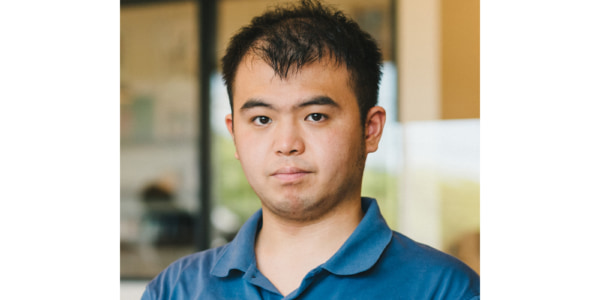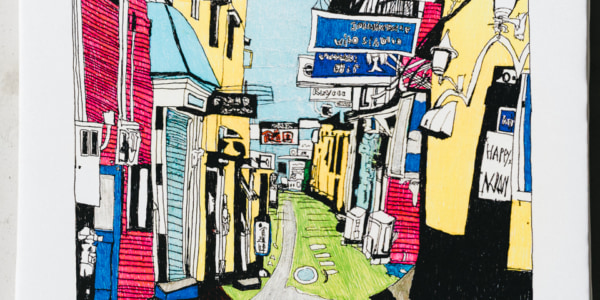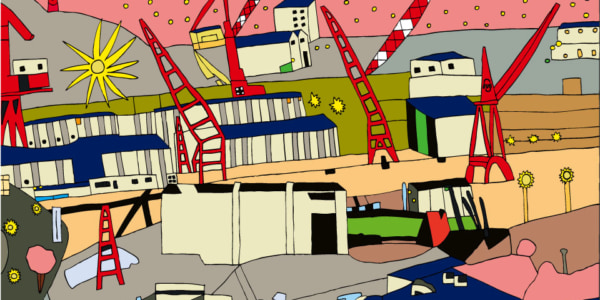Unique patterns drawn to resemble
how things appear to the artist
On this particular day at MINATOMACHI FACTORY in Sasebo, Nagasaki, raito was drawing a picture of a flying fish in his sketchbook and was busy filling in detailed patterns.
![[Photograph]](https://www.diversity-in-the-arts.jp/admin/wp-content/uploads/2022/08/img_raito-04.jpg)
With a serious expression on his face, raito draws a detailed pattern on his flying fish picture.
He places a ruler over the area he is working on and slowly moves the pencil, which has been sharpened to a fine point. Despite this, the ruler is not something he uses to draw lines; the drawing is done freehand.
On his desk, he always keeps a desktop pencil sharpener, a pen case, and a water bottle. He positions his face close to the sketchbook, occasionally making corrections by erasing lines with an eraser. Then he pauses his hand and looks carefully at the work in progress. Raito’s meticulous creations take shape with extreme care. It takes about three to four months to complete one drawing.
![[Photograph]](https://www.diversity-in-the-arts.jp/admin/wp-content/uploads/2022/08/img_raito-05-960x641.jpg)
Raito picks up the photo of the flying fish he is modeling his drawing on.
![[Photograph]](https://www.diversity-in-the-arts.jp/admin/wp-content/uploads/2022/08/img_raito-06.jpg)
Raito looks closely at the reference photo.
![[Photograph]](https://www.diversity-in-the-arts.jp/admin/wp-content/uploads/2022/08/img_raito-07.jpg)
The ruler that accompanies the pencil is not used to draw lines. He draws all of the detailed shapes freehand.
The complex lines and patterns began to appear in his work at the same time he began using MINATOMACHI FACTORY in 2016. When asked about the patterns, raito said:
“This is how they look to me.”
His manner of speaking was formal and polite.
Treasured tools arranged neatly
atop a spotless desktop
The pencil raito was using was so short that it was hidden in his fist. His ruler was broken in the middle. Despite this, raito says:
“It is still usable. I just use the parts I can.”
He immediately put away the tools not in use in his bag.
“I don’t think it is good to be too messy.”
This too, he says politely.
Sometimes, he draws his work in pencil and then colors it in with colored pencils. Other times, he layers the colors at the suggestion of a staff member, adding colored markers on top of the colored pencils.
![[Photograph]](https://www.diversity-in-the-arts.jp/admin/wp-content/uploads/2022/08/img_raito-08.jpg)
A view of raito’s desk with work in progress. Familiar tools such as a sharp pencil, well-worn eraser, a broken but still usable ruler, and a pencil sharpener are laid out on the desk.
![[Photograph]](https://www.diversity-in-the-arts.jp/admin/wp-content/uploads/2022/08/img_raito-09.jpg)
A drawing of MIYAZAKI Hayao by raito. The colors were added by a former member of MINATOMACHI FACTORY. The work is on display at and.basic, a company under the same management as MINATOMACHI FACTORY.
Both the characters and the story are his forte. An original, full-length manga fills 11 notebooks.
Raito also happens to be a manga artist. Since 2020, he has been drawing an original manga series, That’s Raito, in large-sized notebooks. It’s a huge endeavor, and he is now working on its 11th volume. The first page of every volume is in color, just like commercial manga serialized in magazines. The story touches on art club activities, friendship, and romance. It seems like a school life story, but then there’s a scene in which a dinosaur makes an appearance. The characters are modeled on teachers and friends at the school that raito actually attended.
![[Photograph]](https://www.diversity-in-the-arts.jp/admin/wp-content/uploads/2022/08/img_raito-11.jpg)
Raito’s bag contains nearly 20 neatly stacked notebooks.
![[Photograph]](https://www.diversity-in-the-arts.jp/admin/wp-content/uploads/2022/08/img_raito-12.jpg)
That’s Raito, his original manga, drawn in a large-sized notebook. The first page is colored with colored pencils.
![[Photograph]](https://www.diversity-in-the-arts.jp/admin/wp-content/uploads/2022/08/img_raito-13.jpg)
Raidog, an original character by raito, drawn in a large-sized notebook. The character’s features are described in detail: “He can run faster than a horse, is stronger than a polar bear, and can fly faster than a swallow.”
![[Photograph]](https://www.diversity-in-the-arts.jp/admin/wp-content/uploads/2022/08/img_raito-14.jpg)
The lower left page of the notebook is Raidog. The upper right page is Mei-chan in an animal suit. Both are raito’s original characters.
![[Photograph]](https://www.diversity-in-the-arts.jp/admin/wp-content/uploads/2022/08/img_raito-15.jpg)
The novel version of The Nightmare Before Christmas, one of raito’s favorite stories, which he happened to have with him that day.
He also has a notebook for drawing characters that he comes up with himself. Raito, a white dog with black spots, transforms into a robot dog called Raidog. Keta is an anthropomorphic mini truck. According to the description paired with the illustration, Keta is “kind-hearted, but wants to be young again.” Raito also includes the name of the voice actor that he envisions would voice the character in the anime adaption.
The manga and character illustrations are not decorated with patterned lines. His drawings are drawing-like, and his manga are manga-like. They are simply different modes of expression.
Raito straightened the notebooks that he showed us and tucked them back into his bag, then returned to drawing his picture. The flying fish was a motif suggested by a staff member because it is used as an ingredient in agodashi (flying fish soup stock), a Nagasaki specialty. Raito examines at the photo as he draws. He told us that he’s drawing the flying fish, even though he is not particularly interested in it.
If not flying fish, what does he like? Trains and dogs, he says. Going to nice stores and the library. Thomas the Locomotive, TEZUKA Osamu, and the manga KochiKame: Tokyo Beat Cops.
The patterns that raito draws are reportedly becoming more and more detailed. Indeed, compared to his previous works, the patterns occupy a larger area of the flying fish drawing, although it is still a work in progress.
“This is how they look to me.”
Having said this, raito is still only in his 20s. How will he change from now on, and what kind of lines will he use to capture the world in the future? One thing is likely to remain the same: the pencils, ruler, and erasers that raito handles so carefully will probably be arranged neatly on his desk just as they are now.
![[Photograph]](https://www.diversity-in-the-arts.jp/admin/wp-content/uploads/2022/08/img_raito-17.jpg)
Looking at the camera, raito showed us a variety of expressions.




![[Photograph]鉛筆を手に、しゃんとした姿勢でこちらを見るraitoさん](https://www.diversity-in-the-arts.jp/admin/wp-content/uploads/2022/08/img_raito-01.jpg)
![[Works]](https://www.diversity-in-the-arts.jp/admin/wp-content/uploads/2022/08/img_raito-03a.jpg)
![[Works]raitoさんによる人物の線画。細かな線と図形がいたるところに描かれている。](https://www.diversity-in-the-arts.jp/admin/wp-content/uploads/2022/08/img_raito-03b.jpg)
![[Works]raitoさんによる犬を描いた作品。着彩は色鉛筆。内側に文様があるほか、輪郭線の一部が海岸線のようになっている。](https://www.diversity-in-the-arts.jp/admin/wp-content/uploads/2022/08/img_raito-10a-1-960x700.jpg)
![[Works]raitoさんによるライオンを描いた線画。緻密な線と図形が部分的に描き込まれている。](https://www.diversity-in-the-arts.jp/admin/wp-content/uploads/2022/08/img_raito-10b-1-960x704.jpg)
![[Works]raitoさんによる電車を描いた作品。着彩は色鉛筆とカラーペン。](https://www.diversity-in-the-arts.jp/admin/wp-content/uploads/2022/08/img_raito-10c-1-960x672.jpg)
![[Works]raitoさんによる長崎市内の眼鏡橋を描いた作品。着彩は色鉛筆とカラーペン。](https://www.diversity-in-the-arts.jp/admin/wp-content/uploads/2022/08/img_raito-10d-960x648.jpg)
![[Works]raitoさんによるベートーヴェンを描いた線画](https://www.diversity-in-the-arts.jp/admin/wp-content/uploads/2022/08/img_raito-16a-4.jpg)
![[Works]raitoさんによる演奏中のジミ・ヘンドリックスを描いた線画](https://www.diversity-in-the-arts.jp/admin/wp-content/uploads/2022/08/img_raito-16b-1.jpg)
![[Works]raitoさんによる夏目漱石を描いた線画](https://www.diversity-in-the-arts.jp/admin/wp-content/uploads/2022/08/img_raito-16c-2.jpg)
![[Works]raitoさんによるクレオパトラを描いた線画](https://www.diversity-in-the-arts.jp/admin/wp-content/uploads/2022/08/img_raito-16d.jpg)
![[Works]raitoさんによるマリリン・モンローを描いた線画](https://www.diversity-in-the-arts.jp/admin/wp-content/uploads/2022/08/img_raito-16e-1.jpg)
![[Works]raitoさんによるマリリン・モンローを描いた作品。カラーペンで着色したもの](https://www.diversity-in-the-arts.jp/admin/wp-content/uploads/2022/08/img_raito-16f.jpg)


